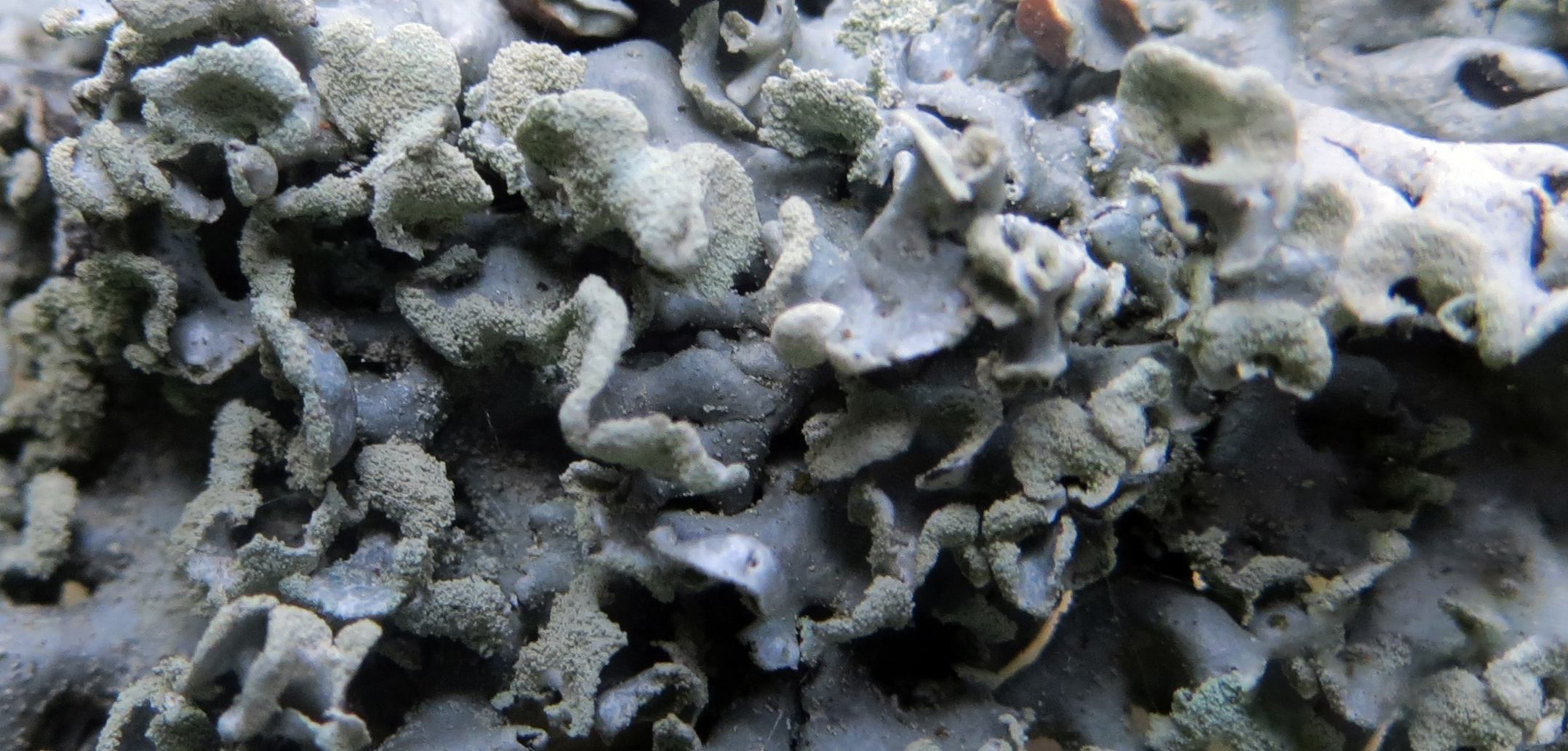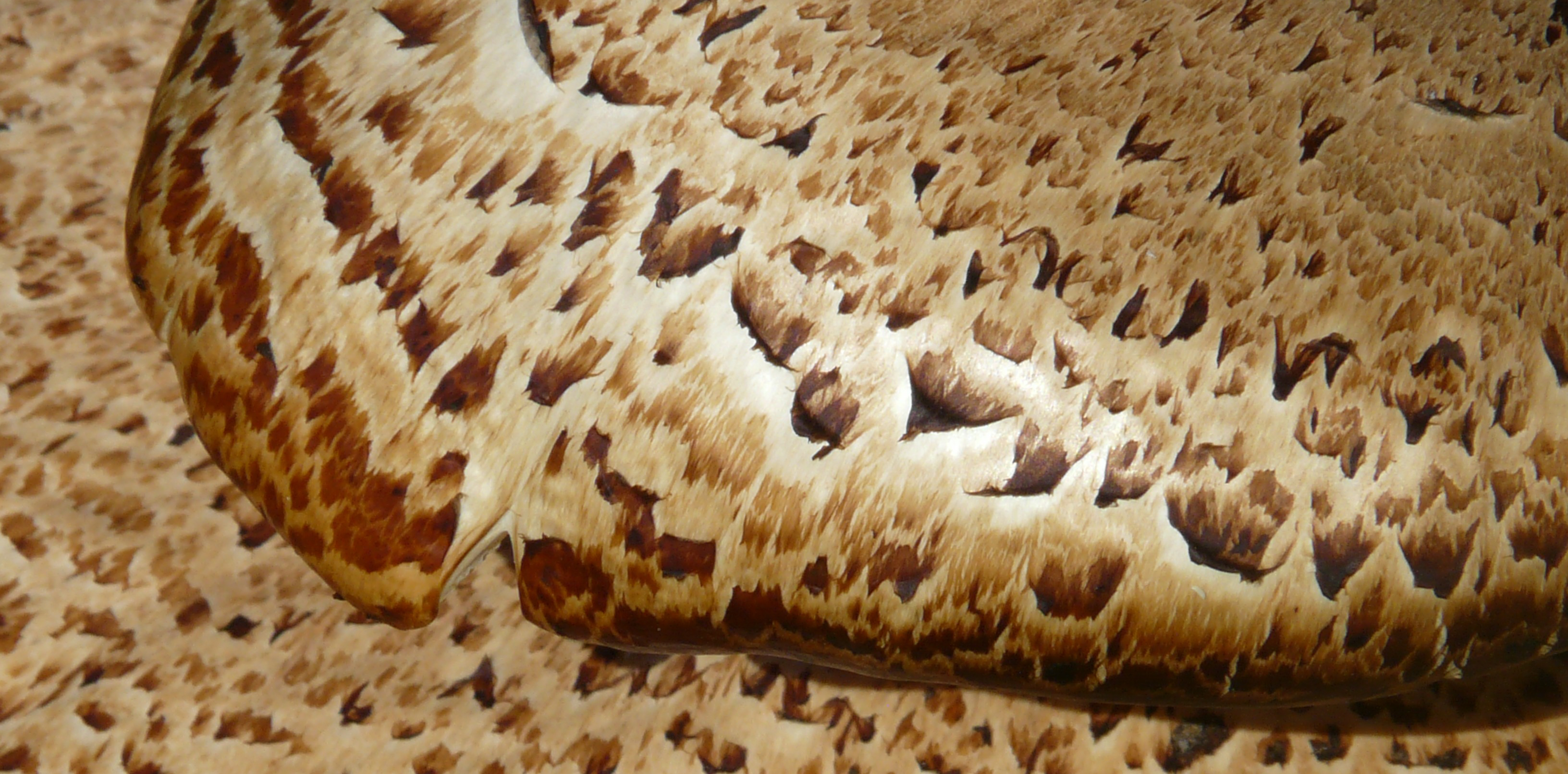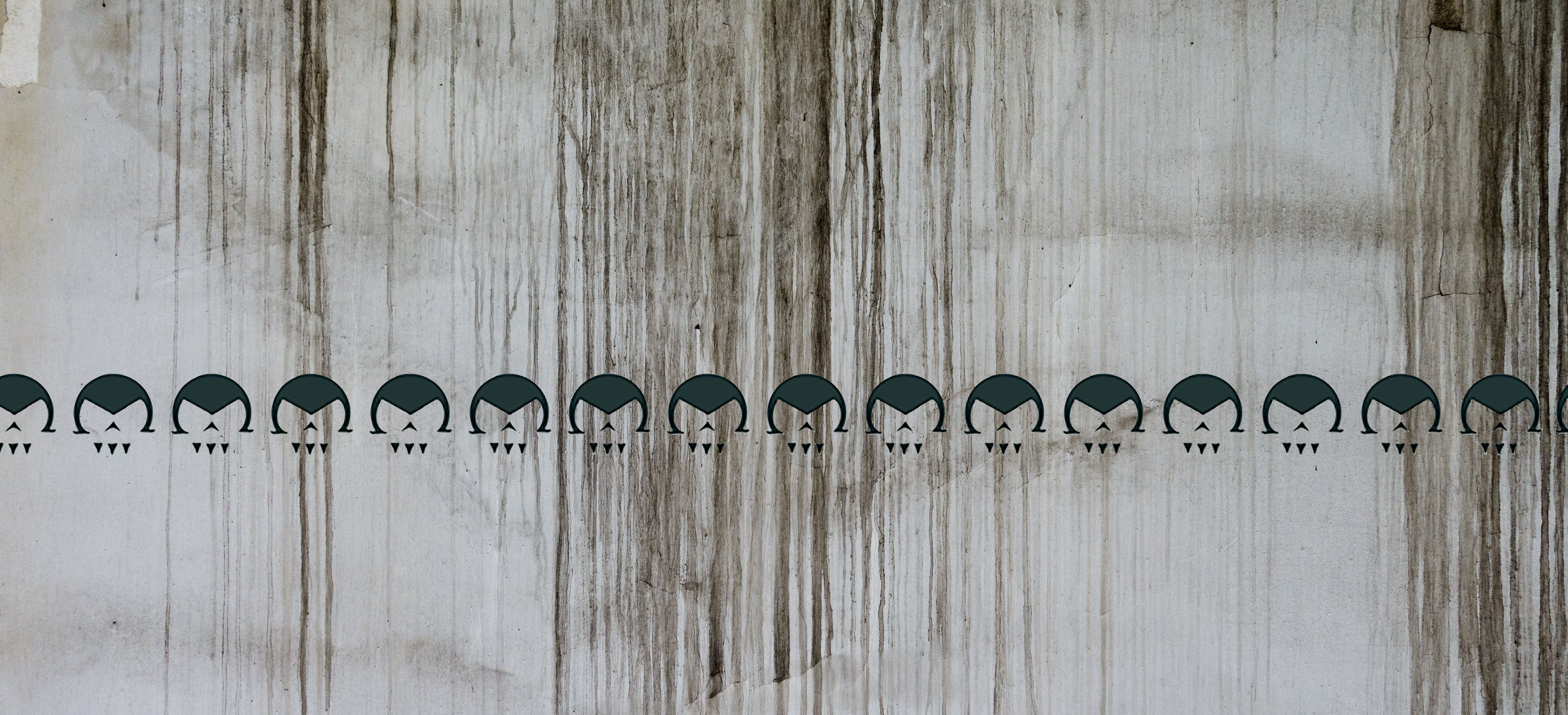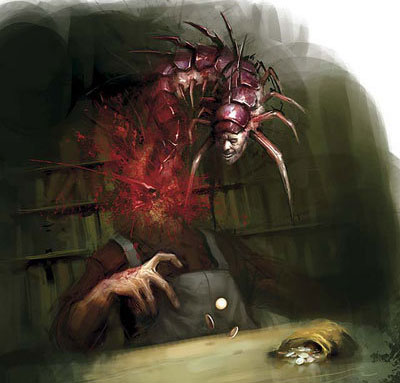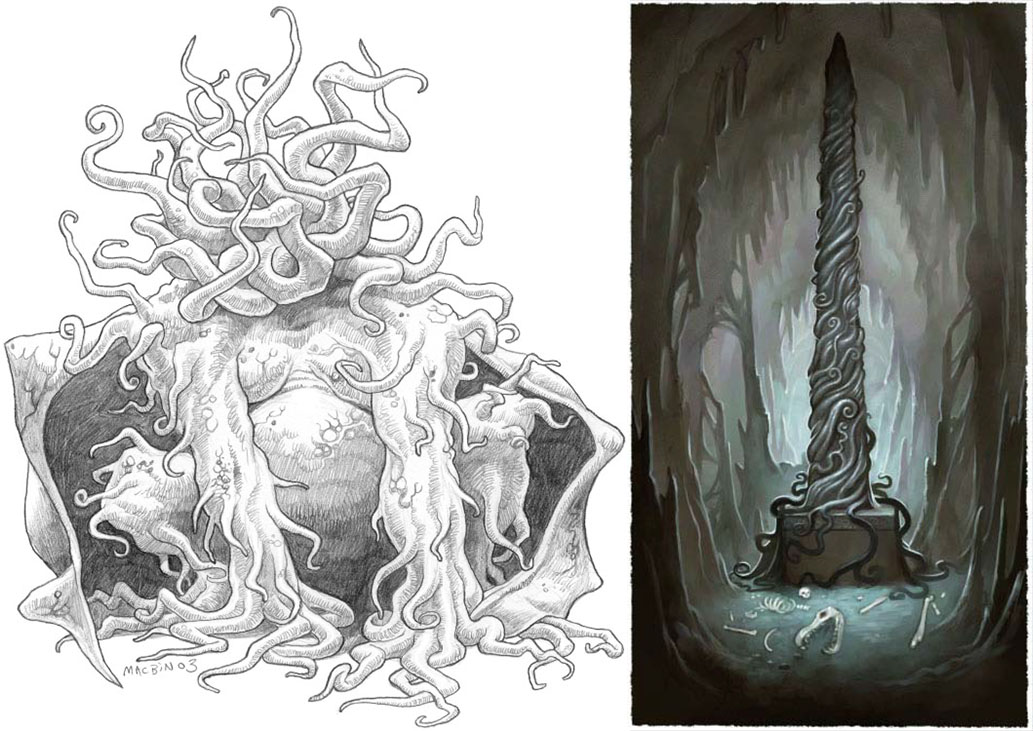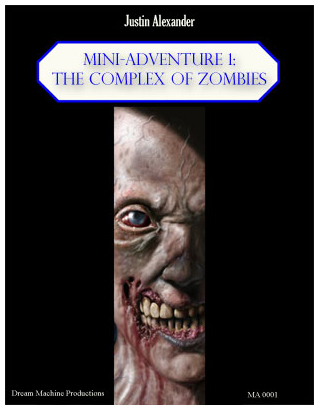AREA 1-14 THE PITS
The air smells of vomit and rot. Three of the ten-foot-by-ten-foot pits in the center of this room are partially filled with thick, noxious chemicals. One of the pits appears to be filmed over with a thick, fungal growth.
The remnants of some sort of mechanical contraption hang in shattered, rusting ruins from the ceiling. You can make out a large hook of some sort dangling down and what may have been tracks for moving the hook back and forth.
GM Background: The alchemical concoctions perfected in Area 1-12 were poured into these pits and the experimental subjects from Area 1-13 were then lowered into the pits. Successful transformations would be transferred to the Arena (Areas 1-19 thru 1-23).
PITS: The pits are 30 feet deep and filled about 20-25 deep with the alchemical mixtures. (The effects of the pit liquids are described below.)
- FORT SAVE (DC 14): Anyone leaning over the pit must make a Fortitude save or vomit.
SECRET DOOR (SEARCH, DC 14): This secret door requires the use of a key to open. The key is long gone. The door is made of stone, but the latch mechanism can be broken more easily. (Break DC 28, hardness 8, hp 90)
MOTILE MOLD: The fungus skimming over one of the pits is, in fact, a collection of 10 motile molds.
MOTILE MOLD (CR 1) – N Medium Plant
DETECTION – blind, blindsight 60 ft., Listen +0; Init -1; Aura swamp gas (30 ft.)
DEFENSES – AC 13 (-1 Dex, +4 natural), touch 9, flat-footed 13; hp 11 (2d8+2); Immune acid, gaze attacks, illusions, plant immunities (critical hits, mind-affecting, paralysis, poison, polymorph, sleep, stunning), visual effects; Weakness vulnerability to fire
ACTIONS – Spd 20 ft.; Melee acid touch +1 (1d6 acid); Ranged +0; Space 5 ft.; Reach 5 ft.; Base Atk +1; Grapple +1; SA decomposing slime, death burst, engulf
SQ plant traits (breathe, but do not sleep), swamp gas (30 ft.)STR 11, DEX 8, CON 13, INT 1, WIS 10, CHA 5
FORT +4, REF -1, WILL +0
FEATS: Track
SKILLS: Hide +2 (+12 in marsh/swamp), Listen +0, Survival +2Death Burst (Ex): When destroyed, explodes. 10 ft.—Reflex DC 12 (half), 1d4 acid damage. Save DC is Constitution-based.
Decomposing Slime (Ex): Touching or striking motile mold inflicts 1 acid damage.
Engulf (Ex): Standard Action—Envelop creatures of its size or smaller by moving into their space. Target can make Reflex save (DC 12) or attack of opportunity, but not both. On successful save, target can move aside or or back (target’s choice) out of the mold’s path. Save DC is Constitution-based.
Engulfed creatures are considered grappled within the mold’s body and are subject to its decomposing slime once per round.
Swamp Gas (Ex): 30 ft. aura—Fort save (DC 12) or sickened for 10 rounds. Poison effect. Cannot be affected again for 24 hours after successful save. Save DC is Constitution-based.
Skills: +10 racial bonus on Hide checks in marsh/swamp terrain.
THE PITS
Any creature completely covered in one of the liquids must succeed at a Fortitude save or become altered in some way. The effect ends after d8+2 minutes at which time the fluid has suffused the victim’s body and entered the stomach. The victim’s body rejects the fluid and vomits it out. The victim must succeed at a Fortitude save (DC 20) or cough up a good amount of blood, too, suffering 2d6 damage.
(The researchers would stabilize the mutations with a separate alchemical compound, now lost.)
PIT A: : Fortitude save (DC 17). Victim’s neck becomes elongated, growing to twice its normal length. All down the sides it grows gill-like openings that emit a series of horribly shrill, chittering sounds when the victim exhales. Anyone hearing these sounds must make a Will save (DC 15) or become dazed for one round with visions of pale, blabbering mouths, drooling and laughing in their face. (The victim is not affected by this.)
When the effect ends, the gills wither and fall off while the neck returns to its normal length. This process inflicts 2d8 points of damage.
PIT B: Fortitude save (DC 20). Victim’s skin sprouts hundreds of chitin spikes, completely ruining any clothes or leather armor they may be wearing. Victims wearing full metal armor suffer d4 damage each round until the armor is removed. The spikes are fairly brittle, though, and can only be used offensively in a grapple, in which case they do 1d6 piercing damage.
When the effect wears off, the victim is left with small, round scars all over their body.
PIT C: Fortitude save (DC 20). Victim’s eyes explode as two new eyestalks burst from the sockets. This is extremely painful and deals 2d6 points of damage. After 1 round the stalks are fully grown, but the character remains blind for 1d4 rounds.
The eyes are deep red, seven inches long, and each boasts a round, lidless eyeball about the size of a human fist. The victim benefits from 360’ vision (cannot be flanked) and darkvision 60 feet.
When the effect wears off, the eyestalks wither and fall off. The victim suffers 1d4 points of damage and remains blind until a regeneration or similar spell can create new eyes for them.
PIT D: Fortitude save (DC 25). Victim’s teeth retract into their gums and their tongue erupts into a bulbous, five-foot-long, deep red tentacle. The tentacle is completely limp and the victim cannot control it in any way.
When the effect wears off, the tentacle slowly reduces in size back to a normal tongue and the teeth slowly return to their normal positions over the course of 1d4 hours.
(These pits are adapted from “Modification Complex No. 47” by Skrir.)
AREA 1-15 ADMINISTRATOR’S OFFICE
The air in this room is incredibly stale. A small wooden desk has been half-rotten through. What appear to have once been large crates are stacked in the corners, although many of these have collapsed under the weight of years.
LISTEN (DC 10): The sound of deep, laborious breathing echoes through the room.
THE GENTLE HOUND: A large, gracile creature with chocolate-brown fur lies in an impossibly deep hibernation behind the desk. Its neck and hind legs are curiously elongated (causing it to walk and run in a loping fashion).
- It takes serious effort to wake up.
- It will be friendly unless provoked, in which case it will fight back. If seriously injured, it will run down the hallway and operate the secret door, escaping into the larger complex.
- Use stats of a dire wolf.
- GM Background: This creature was a failure of the experiments that took place here; it has a gentle nature, quite out of character with what Ghul wanted in his hounds. The administrator kept it as a pet, but it was abandoned here when Ghul’s empire fell.
SEARCH (DC 18):
- 3 masterwork longspears (once used to keep the beasts under control)
- small gem purse (870 gp worth of gems)
AREA 1-16 – BLUESTEEL DOOR
This is another bluesteel door. No password has been inscribed nearby.
AREA 1-17 – ESCAPE TRAP
This room is empty.
SPOT (DC 18): Several dozen holes have been drilled into the walls of the chamber. They appear to form a curious, flowing pattern.
TRAP (CR 3): mechanical, location trigger, manual reset, Atk +10 ranged (1d6/x3, arrow); multiple targets (fires 2d4 arrows at each target in the room, 1d4 arrows at each target in the first 10 feet of the hallway); Search DC 18, Disable Device DC 20.
- The arrows hit everyone EXCEPT the person standing on the trigger plate.
SECRET DOOR: Search DC 18 (or DC 30 if trap is not sprung). One of the arrows on the far wall will appear to malfunction: It will dangle uselessly from the hole it shot out of. In reality, this is the switch for the secret door — pulling on the arrow causes the door to swing open.
GM Background: Someone being pursued could run into this room, trigger the trap, and perforate their closest pursuers. They could then activate the secret door and slip away.

